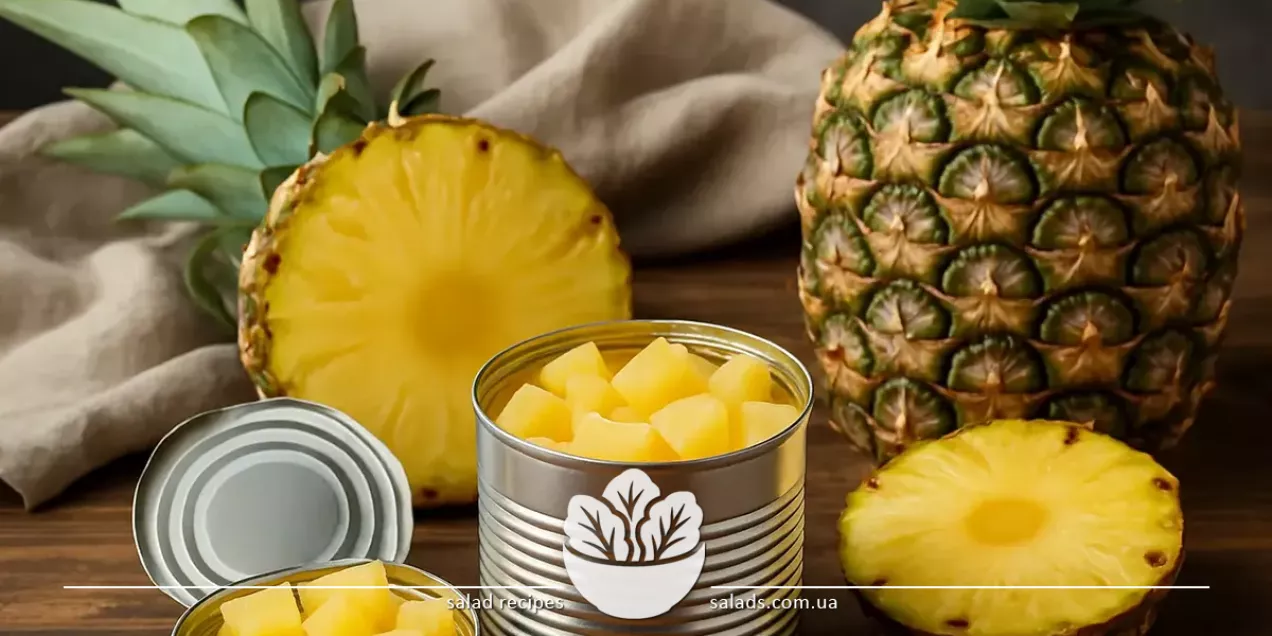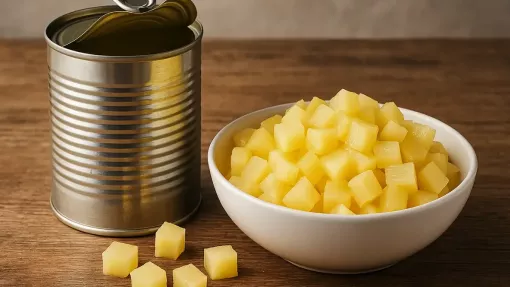Pineapples

Pineapples are tropical fruits that combine refreshing tartness, pronounced sweetness, and a vivid aroma. Their flesh is dense and juicy, offering a rich flavor profile that pairs well with both sweet and savory ingredients. Within the fruits category, pineapples stand out for their versatility and availability in multiple forms: fresh, canned, dried, and caramelized.
Different Types of Pineapples
Fresh Pineapple: Maximum Flavor and Vitamins
Fresh pineapple is the most aromatic and juicy form of this fruit. Its flesh has a bright yellow color, a firm yet tender texture, and a rich taste that balances sweetness with slight acidity. In its fresh form, pineapple is a source of vitamin C, manganese, antioxidants, and the enzyme bromelain, which aids in protein digestion. Fresh pineapples are commonly used in salads, fresh juices, smoothies, fruit platters, and also paired with meat, fish, or cheese. For example, a salad with pineapple, chicken fillet, greens, and hard cheese is a classic dish for festive meals or a light lunch. Additionally, fresh pineapple is perfect for carpaccio, gazpacho, or spicy sauces for meat.
A distinctive feature of this fruit is that its flavor and sweetness depend significantly on its ripeness. A ripe pineapple has a strong aroma, a soft core, and easily detachable skin. In stores, fresh pineapples are available whole or pre-cleaned and sliced – in rings, wedges, or chunks. In cooking, fresh pineapple purée is often added to desserts, yogurts, or baked goods to provide freshness and natural sweetness. Thanks to its vitamin C and enzymes, pineapple is also beneficial during the winter season to support immunity.
Canned Pineapple: Convenience and Consistent Flavor
Canned pineapple is a popular alternative to fresh fruit, especially when consistent quality and easy storage are needed. It is sold as rings, slices, chunks, or crushed flesh, usually in syrup, juice, or with no added sugar. Due to pasteurization and airtight packaging, canned pineapple has a long shelf life and is available year-round. It’s used in a wide range of dishes – from salads to baked goods. For instance, pineapple chunks are often added to pizza, casseroles, chicken and meat dishes, and desserts. A good example is a casserole with chicken, pineapple, and chicken eggs – a simple yet vibrant main course for a family lunch.
In confectionery, canned pineapple is commonly used for cakes, roulades, cheesecakes, and cobblers. Its sweetness and light acidity pair well with creamy fillings, cheese-based batters, and pastry dough. In chilled desserts like jelly or ice cream, pineapple brings fruity freshness. Canned pineapple is convenient because it requires no peeling, washing, or processing. It’s ready to use, pre-cut, and texture-stable, making it ideal for both professional kitchens and home use – especially when a quick exotic twist is needed.
Grilled Pineapple: Caramelized Flavor and a New Culinary Accent
Grilled pineapple is a preparation method that reveals new flavor dimensions of the fruit. With heat, natural sugars caramelize, the flesh becomes even softer, and the aroma deepens and intensifies. This type of pineapple retains its juiciness but gains a slightly browned crust, making it especially appealing in both sweet and savory dishes. Grilled pineapple is served as a side to meat, fish, or poultry, or as a stand-alone dessert – with yogurt, ice cream, or paired with honey and spices. For example, grilled pineapple with honey, lime, and herring as a canapé is an unusual yet well-balanced appetizer. In vegetarian cuisine, it is served with grains, chickpeas, cilantro, or yogurt-based sauces.
Fresh pineapple, sliced into rings or wedges, is best for grilling. It can be seared on a grill pan, baked in the oven, or cooked over charcoal. For added flavor, pineapple is sometimes marinated in lemon juice, honey, spices, or balsamic vinegar before cooking. Grilled pineapple is a combination of fruity freshness and warm aroma that adds gastronomic depth to dishes. It makes familiar recipes more original and enhances both everyday meals and festive presentations.
Dried Pineapple: Convenient Snack and Concentrated Flavor
Dried pineapple is a concentrated version of fresh fruit with a pronounced sweet-and-sour flavor. During drying, most of the moisture is removed, intensifying its natural sweetness and aroma. It’s available as rings, cubes, or strips – either plain or with added sugar and flavorings. This form retains some vitamins and trace elements, including manganese, vitamin C, copper, and antioxidants. Dried pineapple is a convenient snack, perfect for taking on the go, and a great addition to muesli, granola, bars, porridge, baked goods, or homemade sweets. For example, oatmeal bars with dates, tuna, and dried pineapple combine protein, energy, and fruity freshness in one serving.
Beyond desserts, dried pineapple can be paired with meat in Eastern dishes, added to sauces, or used in salads for sweet contrast. It is also widely used in vegan cooking – in snacks, sauces, or as a sugar-free candy alternative. Thanks to its long shelf life and resistance to temperature changes, dried pineapple is perfect for long trips, lunch boxes, or kitchen reserves. It’s a tasty and nutritious product easily adapted to various eating styles.
Pineapple in Baking and Desserts: A Bright Fruity Note
Pineapple shines in desserts and baked goods, where its sweet-and-sour flavor adds pleasant balance and highlights other ingredients. With its high juiciness and strong aroma, pineapple softens batter, moistens cakes, and adds lightness. It’s used in pies, muffins, pastries, cake fillings, cheesecakes, jellies, and puddings. The upside-down pineapple cake is especially popular – a classic American dessert where pineapple slices caramelize with butter and sugar, creating a golden topping. Pineapple is also added to cheese casseroles, strudels, or sponge cakes. For example, a pie with canned pineapple and dried mackerel in savory dough is an unconventional option for gastronomic enthusiasts.
In cold desserts, pineapple is used in mousses, ice cream, panna cotta, jellies, and smoothie bowls. It pairs well with cream cheese, yogurt, coconut, white chocolate, almonds, and citrus fruits. Its pleasant acidity also helps balance sweetness in layered desserts. Pineapple is an ingredient that not only decorates but defines the character of a dessert. It adds a tropical note, visual appeal, and fresh fruit flair suitable for both home and restaurant cuisine.
